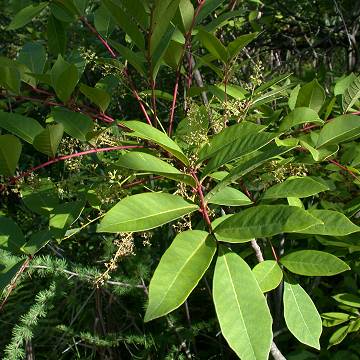

Toxicodendron vernix - (image 1 of 9)
Taxonomy
Family: Anacardiaceae
Synonymous with Rhus vernix L.
Habitat
Typically found in bogs or the edges of swamps.
Associates
Includes Aronia prunifolia (black chokeberry), Betula pumila (Bog birch), Drosera intermedia (intermediate sundew), Dryopteris thelypteris var. pubescens (Marsh fern) Ilex verticillata (winterberry holly), Osmunda regalis (royal fern), Osmunda cinnamomea (cinnamon fern), Larix laricina (Tamarack), Potentilla palustris (marsh cinquefoil), and Sarracenia pupurea (Pitcher plant)
Distribution
Southern ME and southwest Nova Scotia west to MN and southwest Ontario, south FL to TX.
Morphology
Shrub or small tree to 5 m, often multi-stemmed. Bark light gray and rather smooth; twigs hairy and dark green when young, becoming smooth and brownish yellow with prominent lenticels. Leaves deciduous, alternate, pinnate compound; leaflets 7-13, entire, smooth green above and lighter beneath, oblong to obovate or elliptic, 4-5 cm, acute to acuminate, acute at the base; rachis often reddish. Inflorescence axillary, racemose, to 20 cm; flowers white or greenish-white. Fruit a grayish-white drupe, 4-5 mm, in loose drooping clusters, persisting into the winter.
Notes
Flowers early June to late June
Wetland indicator: Obligate
Poison Sumac produces a resinous oil (Urushiol) like that found in Poison ivy. The oil darkens when exposed to the air. In southern Wisconsin it is frequently found around the borders of conifer swamps where the swamp transitions to upland. It is reported to induce an allergic reaction in people reasonably immune to the effects of poison ivy. The fall color is quite stunning. The persistent fruit probably represents an important winter food source for birds and small mammals.
The Wikipedia page for Poison Sumac (July, 2009) makes the claim that, "According to some botanists, poison sumac is the most toxic plant species in the United States", which is very misleading. This statement found its way onto a cable TV show called 1000 Ways to Die, in a scene that portrayed two teenagers who die from smoking Poison Sumac after they run out of Marijuana (the plant they used on the show did not look even remotely like Poison Sumac). Many plants could prove fatal if smoked, and it is debatable whether or not Poison Sumac is one of them. The mode of death would be asphyxiation, provided the blistering of the respiratory tract was severe enough to prevent breathing. Also, not all individuals are allergic, so for them the plant is completely harmless. Ingestion of the plant can cause a systemic reaction in some individuals, but this depends on not only the person being susceptible but also that the person ingest or smoke the plant. With regard to fatalities there are far more toxic plants in the U.S. For example, a single bite of the root of Water Hemlock can be fatal and in this case toxicity is more a function of body mass than individual susceptibility.
References
Curtis, J. T. 1959. Vegetation of Wisconsin.
University of Wisconsin Press. Madison, Wisconsin.
Gleason, Henry A. and A. Cronquist. 1991. Manual of Vascular Plants of Northeastern United States and Adjacent Canada. Second Ed.
The New York Botanical Garden. Bronx, NY.
Swink, F. and G. Wilhelm. 1994. Plants of the Chicago Region.
Indiana Academy of Science. The Morton Arboretum. Lisle, Illinois.
|
Michael Hough © 2005 |